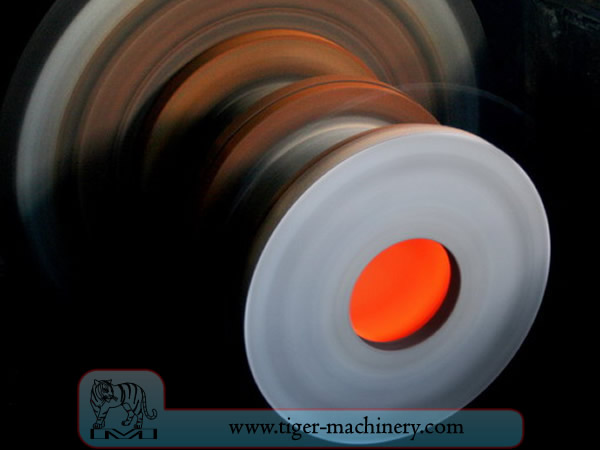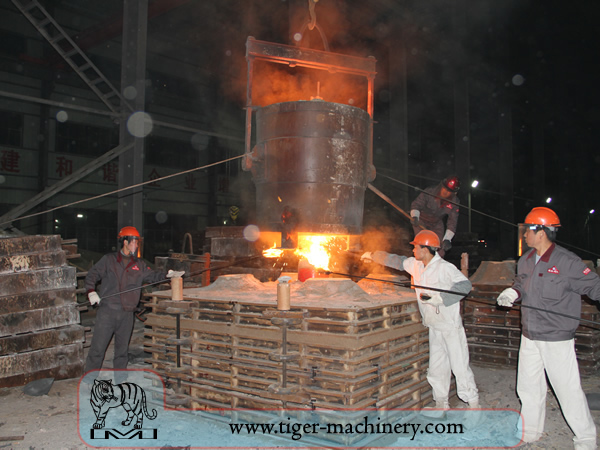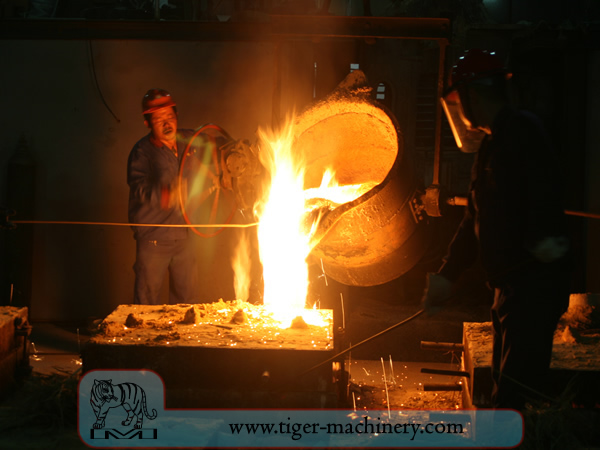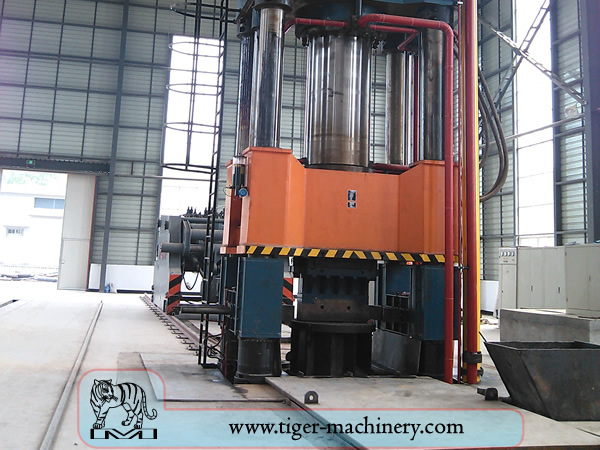تقنية الصب

يمكننا تقديم أجزاء الصب الطرد المركزي، والصب الرملي، وصب القوالب الفراغية، وتكنولوجيا التشكيل بالطرق مع تشغيل جيد ودقيق لمتطلبات صارمة.
الصب الطرد المركزي
In centrifugal casting, a permanent mold is rotated continuously about its axis at high speeds (300 to 3000 rpm) as the molten metal is poured. The molten metal is centrifugally thrown towards the inside mold wall, where it solidifies after cooling. The casting is usually a fine-grained casting with a very fine-grained outer diameter, owing to chilling against the mould surface. Impurities and inclusions are thrown to the surface of the inside diameter, which can be machined away. Casting machines may be either horizontal or vertical-axis. Horizontal axis machines are preferred for long, thin cylinders, vertical machines for rings. Most castings are solidified from the outside first. This may be used to encourage directional solidification of the casting, and thus give useful metallurgical properties to it. Often the inner and outer layers are discarded and only the intermediary columnar zone is used. Centrifugal casting was the invention of Alfred Krupp, who used it to manufacture cast steel tyres for railway wheels in 1852.
ميزات الصب بالطرد المركزي
يمكن تصنيع المسبوكات بأي طول وسماكة وقطر تقريبًا.
يمكن إنتاج سماكات جدار مختلفة من نفس القالب.
Eliminates the need for cores.
مقاوم للتآكل الجوي، وهو وضع نموذجي مع الأنابيب.
Mechanical properties of centrifugal castings are excellent.
Only cylindrical shapes can be produced with this process.
الحدود القصوى للأحجام تصل إلى 3 أمتار (10 أقدام) في القطر و15 مترًا (50 قدمًا) في الطول.
Wall thickness range from 2.5 mm to 125 mm (0.1 - 5.0 in).
حد التسامح: على القطر الخارجي يمكن أن يكون 2.5 مم (0.1 بوصة) وعلى القطر الداخلي يمكن أن يكون 3.8 مم (0.15 بوصة).
يتراوح التشطيب السطحي من 2.5 مم إلى 12.5 مم (0.1 - 0.5 بوصة) جذر متوسط مربع.
فوائد الصب الطرد المركزي
Cylinders and shapes with rotational symmetry are most commonly cast by this technique. "Tall" castings (in the direction of the settling force acting, usually gravity) are always more difficult than short castings. In the centrifugal casting technique the radius of the rotation, along which the centrifugal force acts, replaces the vertical axis. The casting machine may be rotated to place this in any convenient orientation, relative to gravity's vertical. Horizontal and vertical axis machines are both used, simply to place the casting's longest dimension conveniently horizontal. Thin-walled cylinders are difficult to cast by other means, but centrifugal casting is particularly suited to them. To the rotation radius, these are effectively shallow flat castings and are thus simple. Centrifugal casting is also applied to the casting of disk and cylindrical shaped objects such as railway carriage wheels or machine fittings where the grain, flow, and balance are important to the durability and utility of the finished product. Providing that the shape is relatively constant in radius, noncircular shapes may also be cast.

صب الرمل
Sand casting, also known as sand molded casting, is a metal casting process characterized by using sand as the mold material. The term sand casting can also refer to an object produced via the sand casting process. Sand castings are produced in specialized factories called foundries. Over 70% of all metal castings are produced via a sand casting process.
الصب بالرمل رخيص نسبيًا ومقاوم للحرارة بما يكفي حتى لاستخدامه في صب الفولاذ. بالإضافة إلى الرمل، يتم خلط عامل ربط مناسب (عادةً الطين) مع الرمل أو يتواجد معه. يتم ترطيب الخليط، عادةً بالماء، ولكن أحيانًا بمواد أخرى، لتعزيز قوة وليونة الطين وجعل المجموعة مناسبة للتشكيل. يتم احتواء الرمل عادةً في نظام من الأطر أو صناديق القوالب المعروفة باسم القالب. يتم إنشاء تجاويف القالب ونظام البوابة عن طريق ضغط الرمل حول النماذج أو الأنماط، أو نحتها مباشرة في الرمل.
أنماط الصب الرملي
From the design, provided by an engineer or designer, a skilled pattern maker builds a pattern of the object to be produced, using wood, metal, or a plastic such as expanded polystyrene. Sand can be ground, swept or strickled into shape. The metal to be cast will contract during solidification, and this may be non-uniform due to uneven cooling. Therefore, the pattern must be slightly larger than the finished product, a difference known as contraction allowance. Pattern-makers are able to produce suitable patterns using Contraction rules (these are sometimes called shrink allowance rulers where the ruled markings are deliberately made to a larger spacing according to the percentage of extra length needed). Different scaled rules are used for different metals, because each metal and alloy contracts by an amount distinct from all others. Patterns also have core prints that create registers within the molds into which are placed sand cores. Such cores, sometimes reinforced by wires, are used to create under-cut profiles and cavities which cannot be molded with the cope and drag, such as the interior passages of valves or cooling passages in engine blocks.
تشكل المسارات لدخول المعدن إلى تجويف القالب نظام المداخل وتشمل المدخل الرئيسي، ومغذيات مختلفة تحافظ على تدفق جيد للمعدن، والبوابات الداخلية التي تربط نظام المداخل بتجويف الصب. تخرج الغازات والأبخرة المتولدة أثناء الصب عبر الرمل المنفذ أو عبر المنافذ الهوائية، والتي يتم إضافتها إما في النموذج نفسه أو كقطع منفصلة.
صندوق القالب ومواد الصب الرملي
A multi-part molding box (known as a casting flask, the top and bottom halves of which are known respectively as the cope and drag) is prepared to receive the pattern. Molding boxes are made in segments that may be latched to each other and to end closures. For a simple object—flat on one side—the lower portion of the box, closed at the bottom, will be filled with a molding sand. The sand is packed in through a vibratory process called ramming, and in this case, periodically screeded level. The surface of the sand may then be stabilized with a sizing compound. The pattern is placed on the sand and another molding box segment is added. Additional sand is rammed over and around the pattern. Finally a cover is placed on the box and it is turned and unlatched, so that the halves of the mold may be parted and the pattern with its sprue and vent patterns removed. Additional sizing may be added and any defects introduced by the removal of the pattern are corrected. The box is closed again. This forms a green mold which must be dried to receive the hot metal. If the mold is not sufficiently dried a steam explosion can occur that can throw molten metal about. In some cases, the sand may be oiled instead of moistened, which makes possible casting without waiting for the sand to dry. Sand may also be bonded by chemical binders, such as furane resins or amine-hardened resins.
قشعريرة صب الرمل
لتحكم في بنية تصلب المعدن، يمكن وضع صفائح معدنية، أو مبردات، في القالب. التبريد الموضعي السريع المرتبط بذلك سيشكل بنية حبيبية أدق وقد يشكل معدنًا أكثر صلابة إلى حد ما في هذه المواقع. في المسبوكات الحديدية، يكون التأثير مشابهًا لتقسية المعادن في أعمال الحدادة. يتم جعل القطر الداخلي لأسطوانة المحرك صلبًا باستخدام قلب تبريد. في المعادن الأخرى، يمكن استخدام المبردات لتعزيز التصلب الاتجاهي للمسبوك. في التحكم في طريقة تجمد المسبوك، من الممكن منع الفراغات الداخلية أو المسامية داخل المسبوكات.
قلوب صب الرمل
لإنتاج تجاويف داخل الصب - مثل التبريد السائل في كتل المحركات ورؤوس الأسطوانات - تُستخدم أشكال سلبية لإنتاج النوى. عادةً ما تكون النوى مصنوعة من الرمل وتُدخل في صندوق الصب بعد إزالة النموذج. كلما أمكن، يتم تصميم القوالب لتجنب استخدام النوى بسبب الوقت الإضافي للإعداد وبالتالي التكلفة الأعلى.
With a completed mold at the appropriate moisture content, the box containing the sand mold is then positioned for filling with molten metal—typically iron, steel, bronze, brass, aluminium, magnesium alloys, or various pot metal alloys, which often include lead, tin, and zinc. After filling with liquid metal the box is set aside until the metal is sufficiently cool to be strong. The sand is then removed revealing a rough casting that, in the case of iron or steel, may still be glowing red. When casting with metals like iron or lead, which are significantly heavier than the casting sand, the casting flask is often covered with a heavy plate to prevent a problem known as floating the mold. Floating the mold occurs when the pressure of the metal pushes the sand above the mold cavity out of shape, causing the casting to fail.
بعد الصب، يتم تكسير اللب بواسطة قضبان أو طلقات وإزالته من المسبوك. يتم قطع المعدن من المدخل والمنصهرات من المسبوك الخام. يمكن تطبيق معالجات حرارية مختلفة لتخفيف الضغوط الناتجة عن التبريد الأولي وإضافة الصلابة - في حالة الصلب أو الحديد، عن طريق التبريد في الماء أو الزيت. يمكن تعزيز المسبوك بشكل أكبر عن طريق معالجة الضغط السطحي - مثل طلقة الدق - مما يزيد من مقاومة التصدع الشدوي وينعم السطح الخشن.
متطلبات تصميم الصب بالرمل
The part to be made and its pattern must be designed to accommodate each stage of the process, as it must be possible to remove the pattern without disturbing the molding sand and to have proper locations to receive and position the cores. A slight taper, known as draft, must be used on surfaces perpendicular to the parting line, in order to be able to remove the pattern from the mold. This requirement also applies to cores, as they must be removed from the core box in which they are formed. The sprue and risers must be arranged to allow a proper flow of metal and gasses within the mold in order to avoid an incomplete casting. Should a piece of core or mold become dislodged it may be embedded in the final casting, forming a sand pit, which may render the casting unusable. Gas pockets can cause internal voids. These may be immediately visible or may only be revealed after extensive machining has been performed. For critical applications, or where the cost of wasted effort is a factor, non-destructive testing methods may be applied before further work is performed.

صب التشكيل بالتفريغ
Vacuum molding (V-process) is a variation of the sand casting process for most ferrous and non-ferrous metals, in which unbonded sand is held in the flask with a vacuum. The pattern is specially vented so that a vacuum can be pulled through it. A heat-softened thin sheet (0.003 to 0.008 in (0.076 to 0.203 mm)) of plastic film is draped over the pattern and a vacuum is drawn (200 to 400 mmHg (27 to 53 kPa)). A special vacuum forming flask is placed over the plastic pattern and is filled with a free-flowing sand. The sand is vibrated to compact the sand and a sprue and pouring cup are formed in the cope. Another sheet of plastic is placed over the top of the sand in the flask and a vacuum is drawn through the special flask; this hardens and strengthens the unbonded sand. The vacuum is then released on the pattern and the cope is removed. The drag is made in the same way (without the sprue and pouring cup). Any cores are set in place and the mold is closed. The molten metal is poured while the cope and drag are still under a vacuum, because the plastic vaporizes but the vacuum keeps the shape of the sand while the metal solidifies. When the metal has solidified, the vacuum is turned off and the sand runs out freely, releasing the casting.
The V-process is known for not requiring a draft because the plastic film has a certain degree of lubricity and it expands slightly when the vacuum is drawn in the flask. The process has high dimensional accuracy, with a tolerance of ±0.010 in for the first inch and ±0.002 in there after. Cross-sections as small as 0.090 in (2.3 mm) are possible. The surface finish is very good, usually between 150 to 125 rms. Other advantages include no moisture related defects, no cost for binders, excellent sand permeability, and no toxic fumes from burning the binders. Finally, the pattern does not wear out because the sand does not touch it. The main disadvantage is that the process is slower than traditional sand casting so it is only suitable for low to medium production volumes; approximately 10 to 15,000 pieces a year. However, this makes it perfect for prototype work, because the pattern can be easily modified as it is made from plastic.

تزوير
الحدادة هي واحدة من أقدم عمليات تشغيل المعادن المعروفة. تقليدياً، كانت الحدادة تُجرى بواسطة الحداد باستخدام المطرقة والسندان، على الرغم من أن إدخال الطاقة المائية في إنتاج الحديد وتشغيله في القرن الثاني عشر جعل المطرقة والسندان قديمين. تطورت الورشة أو الحدادة على مر القرون لتصبح منشأة ذات عمليات هندسية، ومعدات إنتاج، وأدوات، ومواد خام، ومنتجات لتلبية متطلبات الصناعة الحديثة.
في العصر الحديث، يتم التشكيل الصناعي إما باستخدام المكابس أو المطارق التي تعمل بالهواء المضغوط أو الكهرباء أو الهيدروليك أو البخار. قد تصل أوزان المطارق الترددية إلى آلاف الأرطال. المطارق الكهربائية الصغيرة التي يقل وزنها الترددي عن 500 رطل (230 كجم) والمكابس الهيدروليكية شائعة أيضًا في ورش الحدادة الفنية. لا تزال بعض المطارق البخارية قيد الاستخدام، لكنها أصبحت قديمة مع توفر مصادر طاقة أخرى أكثر ملاءمة.
مزايا وعيوب التشكيل بالطرق
يمكن للحدادة أن تنتج قطعة أقوى من قطعة مسبوكة أو ميكانيكية مكافئة. أثناء تشكيل المعدن في عملية الحدادة، تتشوه حبيباته الداخلية لتتبع الشكل العام للقطعة. نتيجة لذلك، تكون الحبيبات مستمرة في جميع أنحاء القطعة، مما يؤدي إلى قطعة ذات خصائص قوة محسنة.
يمكن تشكيل بعض المعادن بالطرق البارد، ولكن الحديد والصلب يُطرقان دائمًا تقريبًا وهو ساخن. يمنع الطرق الساخن التصلب بالعمل الذي قد ينتج عن الطرق البارد، مما يزيد من صعوبة إجراء عمليات التشغيل الثانوية على القطعة. أيضًا، بينما قد يكون التصلب بالعمل مرغوبًا في بعض الظروف، فإن طرقًا أخرى لتصلب القطعة، مثل المعالجة الحرارية، تكون عمومًا أكثر اقتصادية وأسهل في التحكم. يمكن طرق السبائك القابلة للتصلب بالترسيب، مثل معظم سبائك الألومنيوم والتيتانيوم، وهي ساخنة ثم تصلبها.
يتطلب التشكيل بالإنتاج نفقات رأسمالية كبيرة للآلات والأدوات والمرافق والموظفين. في حالة التشكيل الساخن، تكون هناك حاجة إلى فرن عالي الحرارة (يشار إليه أحيانًا باسم الفرن) لتسخين القوالب أو القضبان. نظرًا لضخامة المطارق والمكابس الكبيرة للأجزاء التي يمكن إنتاجها، بالإضافة إلى المخاطر الكامنة في العمل مع المعدن الساخن، غالبًا ما يكون مبنى خاص مطلوبًا لإيواء العملية. في حالة عمليات التشكيل بالطرق، يجب توفير تدابير لامتصاص الصدمات والاهتزازات الناتجة عن المطرقة. تستخدم معظم عمليات التشكيل قوالب تشكيل المعادن، والتي يجب تشغيلها بدقة ومعالجتها حرارياً بعناية لتشكيل قطعة العمل بشكل صحيح، وكذلك لتحمل القوى الهائلة المعنية.
عمليات التطريق
هناك العديد من أنواع عمليات التشكيل المختلفة المتاحة، ولكن يمكن تصنيفها إلى ثلاث فئات رئيسية:
ممتد: يزداد الطول، وينخفض المقطع العرضي
مستاء: الطول ينقص، المقطع العرضي يزداد
مضغوط في قوالب ضغط مغلقة: ينتج تدفقًا متعدد الاتجاهات
تشمل عمليات التشكيل بالطرق الشائعة: التشكيل بالدرفلة، والتشكيل بالضغط، والتشكيل بالحدادة، والتشكيل بالقوالب المفتوحة، والتشكيل بقوالب مغلقة، والتشكيل بالمكابس، والتشكيل الساخن الآلي، والتشكيل بالحدادة العلوية.